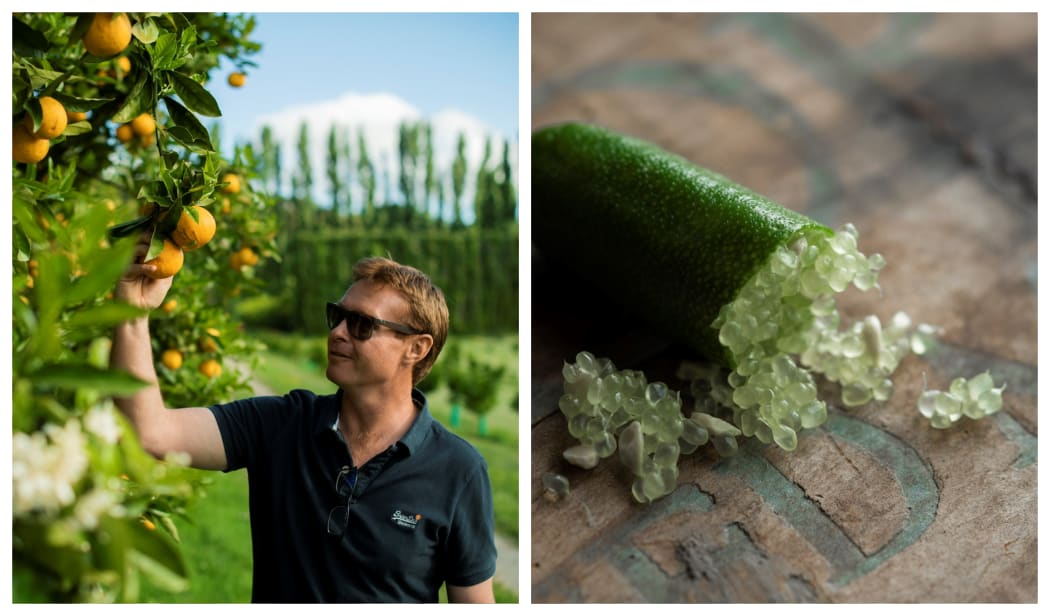Described as the caviar of citrus, finger limes are the hot new ingredient you'll find in high-end restaurants around the world.
They've gained popularity in recent years after being featured on the show Masterchef Australia, but growing them is a prickly business - literally.
When Matt and Cath Carter took over a neglected orchard just outside of Gisborne in 2008, the fruit trees were old and in dire need of regeneration.
Matt and Cath spent six years reviving Hill Road Orchard to its former glory, best known for their fresh orange juice.
They now also grow finger limes, seedless lemons, and even pink variegated lemons.

Oranges and finger limes are just some of the produce grown at Hill Road Orchard. Photo: Hill Road Orchard
The finger limes planted eight years’ ago are now coming into reliable production Matt Carter, co-owner of Hill Road Orchard told Kathryn Ryan.
“They were pretty rare and pretty expensive at the time. But we managed to source a few and since then we've just been developing and grafting them up.
“It's taken quite a while, but they're certainly taking off now.”
The limes have beads which when cut spill out like caviar, he says.
“They look like a little bit like a gherkin, almost a little pepper, a little finger basically.
"You chop them open and inside rather than segments like you have with your normal citrus, they've got loads of little beads. And they're quite hard-skinned. So, when you put them between your teeth, and you get this real burst of lime flavour. That's why they're called citrus caviar.”
This intense flavour makes them attractive to high end restaurateurs, he says.
“They're great with fish, raw fish, fantastic in a gin and tonic. But also like in a salad, you don't necessarily want to put a load of juice into a salad. But you can put these finger lime pearls through a salad and it gives you that real zesty pop as you're going through it.”
They are not, however, an easy tree to care for, he says.
“They are incredibly thorny. They've got very small leaves. And I tend to say that each of those leaves has its own pet thorn. And they are small and sharp, and yet very dangerous.
“We've had some Kevlar-embedded gloves that we use. You can't let the tree get too big because you don't want to actually touch it really, probably a welding apron or something like that would be good.”
The trees also grow inconsistently and produce varying harvests.
"What we found is that you'll have a tree that's got a lot of fruit ready at once. And then the one next to it hasn't got much. And so, there's three or four of us working together in Gisborne at the minute.
“Because of that difference in the tree and the ripening of the fruit, we work together, we've got consistent supply of fruit from say late December, right through to late May, early June.”
He and his partner bought the overgrown orchard back in 2008.
“Some of our navel and Valencia trees were planted in the late ‘60s we believe so they've got huge trunks and huge rootstocks on them.
“And basically, we've just got them back into decent production with a good pruning regime they got quite big.
“As long as you're generating new wood on the tree, you can you can keep growing fruit. And I'll tell you this fruit is some of the best-tasting probably in the region, just with the age of those trees, there's no irrigation, they just sit there and do their thing.”
It took three years to get the old, neglected trees back into shape, he says.
“We were fairly drastic with we used the big hedge trimming machine to take them back virtually to nothing but within three years, they were back into production again.”
They also tread lightly in terms of sprays and fertilisers.
“If we're trying to target a white fly, it's a chemical that only targets white fly and then leaves our beneficials in place.
“But we try not to do that whenever possible. And we work more through our pruning regimes, so there's better airflow through the through the trees in the orchard.
“We do it with feeding them so giving them good nutrition, citrus are what we call a gross feeder. So, they produce a lot of leaf and a lot of fruit. And they need a lot of nutrition to do that.
“And if you can keep the tree healthy, you're less likely to have issues with pests and diseases.”
They are also trying to cut down on weed spraying under the trees, Carter says.
“We're planting different varieties of plants down the rows and under the trees. In fact, in the seedless lemon block yesterday I was just putting in our new grass mix which also includes about six different species of grasses, lucerne, clover marigolds, some chicory and some plantain, so far more diverse to attract a lot more beneficial insects. It's better for the soil as well, because it's tap-rooting down reducing compaction and also fixing some nitrogen with those legumes as well.”

